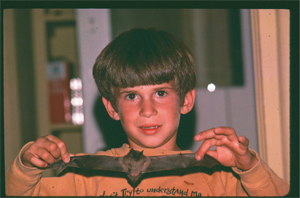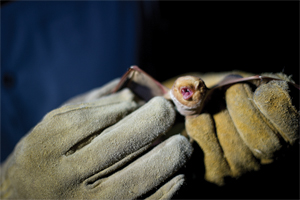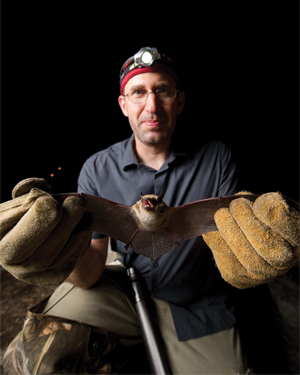The photo of a small boy in a Beatles-style haircut stretching out the wings of a Brazilian free-tailed bat for the camera is a portrait not only of that moment, but of a future.
“That photo is of me at 5-years-old at Carlsbad (Caverns National Park),” said Keith Geluso, pointing to the image on ?the computer screen in his office in Bruner Hall of Science.
Where else, but at the famous bat-filled New Mexico caverns, would the son of a long-time University of Nebraska ?at Omaha bat biologist be when he was hanging out with his dad? “As my mom says, I was brainwashed at an early age by ?my father,” Geluso said.
Today, the younger bat man of the family is completing a 10-year study of bats in the Panhandle of Nebraska to better understand the routine of migratory bats and the dangers they face from future wind turbines that may be built to help meet the growing demand for renewable energy.
Through a Nebraska Game and Parks Commission grant, Geluso is collecting data about the timing and habitats of migratory species in the Wildcat Hills and rugged areas in Cheyenne and Kimball counties.
He explained that there are two major threats to bats in the United States. For hibernating species, particularly in the eastern U.S., the danger is a fungal disease, white-nose syndrome. First identified near Albany, N.Y., it has killed more than one million hibernating bats in eastern North America, according to the U.S. Fish and Wildlife Service, and has spread to 18 states and four Canadian provinces.
For migratory species, the greatest threat is the expansion ?of wind energy in areas such as western Nebraska. “They (bats) seem attracted to the wind turbines,” Geluso said. They get near the blades and die of lung damage.
Some researchers attribute the injuries to an undetectable low pressure zone created as the wind moves through the turbine blades, according to a recent article in Scientific American.
“We don’t know the routes and timing of migratory bats,” Geluso said, which is why he does studies to “fill in the holes” ?in bat knowledge.
 Many of Geluso’s studies on bats, other small mammals, reptiles and birds have led to unexpected findings. After catching only a handful of eastern red bats over about nine years at the Wildcat Hills sites, Geluso and his group of field biologists captured about 50 in 2010. “Every night last year we were catching them,” Geluso said. He has caught a lot of bats over the years, not to mention various species of rats and other small mammals, in Nebraska and New Mexico. Many of his field studies have been conducted in New Mexico, where he received his bachelor’s and doctorate degrees in biology. He holds a master’s degree from the University of Nevada.
Many of Geluso’s studies on bats, other small mammals, reptiles and birds have led to unexpected findings. After catching only a handful of eastern red bats over about nine years at the Wildcat Hills sites, Geluso and his group of field biologists captured about 50 in 2010. “Every night last year we were catching them,” Geluso said. He has caught a lot of bats over the years, not to mention various species of rats and other small mammals, in Nebraska and New Mexico. Many of his field studies have been conducted in New Mexico, where he received his bachelor’s and doctorate degrees in biology. He holds a master’s degree from the University of Nevada.
His skills as a field biologist are much in demand, as reflected by the more than $158,000 worth of grants he has been awarded since 2006, the year he arrived at UNK. The grants have come from the Nebraska Game and Parks Commission, U.S. Fish and Wildlife Service, New Mexico Department of Game and Fish, and UNK. He also has written technical reports for those same entities, plus the National Park Service.
Since 1997, Geluso has authored or co-authored 50 published articles. Of those, 38 have been published since 2006, and he currently has another five manuscripts in review. Among the journals that have published his findings are the Journal of Mammalogy, Western North American Naturalist, Southwestern Naturalist, Aquatic Sciences, Prairie Naturalist, Herpetological Review, Journal of Kansas Herpetology, Occasional Papers of the Museum of Texas Tech University, Bulletin of the University of Nebraska State Museum, Functional Ecology, Texas Journal of Science, Annals of the Entomological Society of America, Physiological and Biochemical Zoology, and Transactions of the Nebraska Academy of Sciences.
Geluso also is in demand to give presentations about his work. Most recently, he was part of a presentation on the interacting effects of land management and hydrology on bird communities along the Platte River. The presentation was given at a joint meeting of the Association for Field Ornithologists, Cooper Ornithology Society and Wilson Ornithology Society held in Kearney.
He has also presented at annual meetings of the Ecological Society of America, Southwestern Association of Naturalists and the American Society of Mammalogists. His expertise on bats brought invitations to present data to the Southeastern Bat Diversity Network and at the North American Symposium for Bat Research.
It was at the University of New Mexico where he met his wife Mary Harner, then a graduate student in biology, specializing in river ecology. “I met her in the Ph.D. program” Geluso said, “actually at my graduation party. We were in the program together, but we were both field biologists. It took three or four tries to schedule the first date.”
Geluso said that they have known from the start not to expect similar schedules or to make plans to be home for supper every night. However, now that they have two young
For the past two years, Harner has worked half-time at the Platte River Whooping Crane Trust near Alda and half-time as a UNK biology faculty member. However, she was recently named the new science director for the Crane Trust and will be full-time there by next spring.
 Together, Harner and Geluso are conducting a study on Crane Trust land to record the results of grazing and burning habitat management practices on reptiles and amphibians. They have a $35,000 Nebraska State Wildlife Grant, which is matched by the Crane Trust and UNK. Also, a $2,500 U.S. Fish and Wildlife Service grant is funding a study of the effects of grazing on the rare Platte River caddisfly.
Together, Harner and Geluso are conducting a study on Crane Trust land to record the results of grazing and burning habitat management practices on reptiles and amphibians. They have a $35,000 Nebraska State Wildlife Grant, which is matched by the Crane Trust and UNK. Also, a $2,500 U.S. Fish and Wildlife Service grant is funding a study of the effects of grazing on the rare Platte River caddisfly.
Teaching has also been important to Geluso, who has taught six biology courses at UNK since joining the faculty in 2006. However, he is using 2011-2012 as a sabbatical year to complete numerous studies and papers, some his own and some with students, on topics that range from the bats of western Nebraska and Crane Trust grazing topics to wood rats, shrews and birds.
He is also assisting in a fish study being conducted by Casey Schoenebeck, a faculty member in the Department of Biology, and a graduate student researcher. Schoenebeck and his student determined that they needed to involve a mammal expert in the study after they found mammals in the stomachs of largemouth bass taken from Interstate 80 sandpits.
Bats and birds always will be Geluso’s first research interests.He said he has taken a bird field guide along on every family vacation since he was a child, and he still enjoys bird watching. The observational skills he developed while watching birds continues to be valuable.
“It seems like everybody knows, identifies and watches birds. I could use my ability to observe birds to watch and study mammals that most people don’t care as much about,” Geluso said.
He doesn’t understand the “eeewwww factor” some people experience when they are around the bats, rats and snakes he studies, because he has loved the outdoors since he was a child watching his dad handle mice and bats. “I grew up with hamsters, snakes and tarantulas. I also had a kangaroo rat as a pet,” Geluso said. “So I don’t study them, because they’re scary,” he added.
As a field naturalist, Geluso’s job is basic science – collecting facts that may say something about the health of ecosystems and how humans have changed them by building dams, contributing to global warming and other factors. “I go out to observe and report things not already in the literature,” he said.
He also is helping people understand the importance of small mammals. For example, kangaroo rats play an important role in dispersing plant seeds in the Sandhills, Geluso said, and insect-eating bats probably save American farmers hundreds of thousands of dollars by consuming agriculture pests.
His appreciation for and knowledge of bats pay an added dividend when they can be used to help UNK biology majors select topics for their required senior thesis. In 2008, he worked with Matt Serbousek of McCook to do a first-of-its-kind bat survey along the Republican River in southwestern Nebraska.
“You set up mist nets in places you think bats frequent and hope you catch them,” Geluso said. The places include the river, its tributaries and some buildings. “Usually, I have a good idea of where they like to come to drink.”
Bats like smooth water, so that is what Geluso and Serbousek looked for in locating mist nets at 15 such sites in five counties from April 2007-2008. “It doesn’t have to be overnight, but in the evenings…The best time to catch bats is right after dusk,” Geluso said.
The first steps for Serbousek were to make a list of bat species he expected to observe and then study their characteristics from collections at UNK and the University of Nebraska State Museum in Lincoln.
One species not expected, Geluso said, was the evening bat, which was our most captured species. Decades-old studies had found only a handful of evening bats in the state, and then only in southeast Nebraska.
“We’re not sure why, but they’re moving in distribution,” he said. “… We have seen mice that have moved westward, squirrels that have moved westward and now bats that have moved westward.
“That’s what science is. Usually, you have an idea or make an observation, and then create a hypothesis. And next you go out and test it.” Geluso has been doing that at work, and on his own, ever since his dad gave him a box of 40 traps and several mist nets when he was an undergraduate student.
“I’d go out with my Mammals of New Mexico (guidebook) just to see if I could capture something, so I could say that I saw it.” He calls it bird watching, but with mammals.
The Internet and more publicity about bats have increased public interest in visiting major bat-viewing sites in New Mexico, Texas and Nevada, Geluso said.
“I think any kind of publicity for bats, and clearing up misconceptions, is good overall for bats. They are part of the ecosystem and are valuable. They’re good for farmers in Nebraska,” he said.
They also are abundant. Geluso said bats make up one-fourth of all mammals in terms of species, with 1,100-1,200. Rats and other rodents make up one-half of the mammalian species, and all other groups are the other one-fourth.
“Why be a bat biologist? A quarter of the mammalian species on earth are bats,” he said, and most of them are in the tropics, where he also has done field studies. “I’m a kid in the candy store down there. You never know what you’re going to get; there are so many species.” Tropical bats fall into five categories by what they eat: fruit, nectar-pollen, blood, animals and insects.
Of the 45 bat species in the United States, 13 inhabit Nebraska and eat insects. Insect-feeding bats also are the main predator of night-flying insects around the world.
Further, most species in the state are hibernators. They do live in caves, but Geluso said, “Bats are very resourceful. They hibernate now in houses, root cellars, sewer systems, mines, you name it. Holes in the ground.” In general, the places where they are “hanging out or roosting” in Nebraska are not likely to be disrupted by humans.
So what makes bats special? “They are the only flying mammals,” Geluso said. And not all bats use echolocation–locating objects by reflected sound. For example, the flying fox, which some see as a “more pleasing bat,” uses its nose and eyes to find fruit.
One of the myths Geluso wants to dispel is that most bats are, well, blind as a bat.
“How do you test how well a bat can see? If you walk into a roost, they’ll follow you with their eyes. If you put your finger in their face, guess what happens?” he said, noting that bats do bite.
Another myth involves vampire bats. They are not out to get people, Geluso said, although he does sleep in a tent while in the tropics where vampire bats live, because they will feed on humans if given a chance. Of the three kinds of vampire bats: only one feeds exclusively on mammalian blood, one feeds on birds and one feeds on both.
Bats can have rabies, but humans are only likely to be infected if they pick up an injured or sick bat off of the ground, and are bitten.
“All the bats that get the virulent strain will die, but they are not carriers as far as I know,” Geluso said. “They don’t have it, spread it and live forever to spread it. Humans are not going to come into contact with a healthy bat.”
And one final thing–bats don’t fly around and get caught in people’s hair.
“I’m in Carlsbad with 300,000 bats flying by me, and I don’t get attacked,” Geluso said. “Of course, I don’t have much hair on my head these days, so this may not be the best evidence to dispel that myth.”
